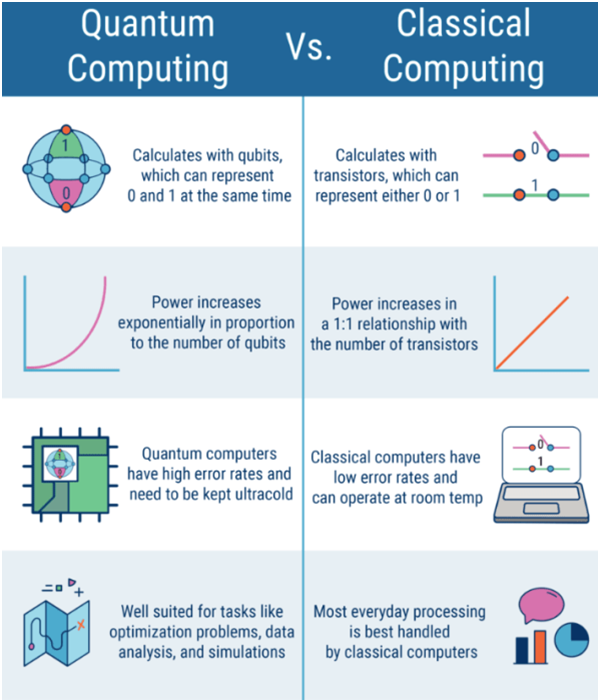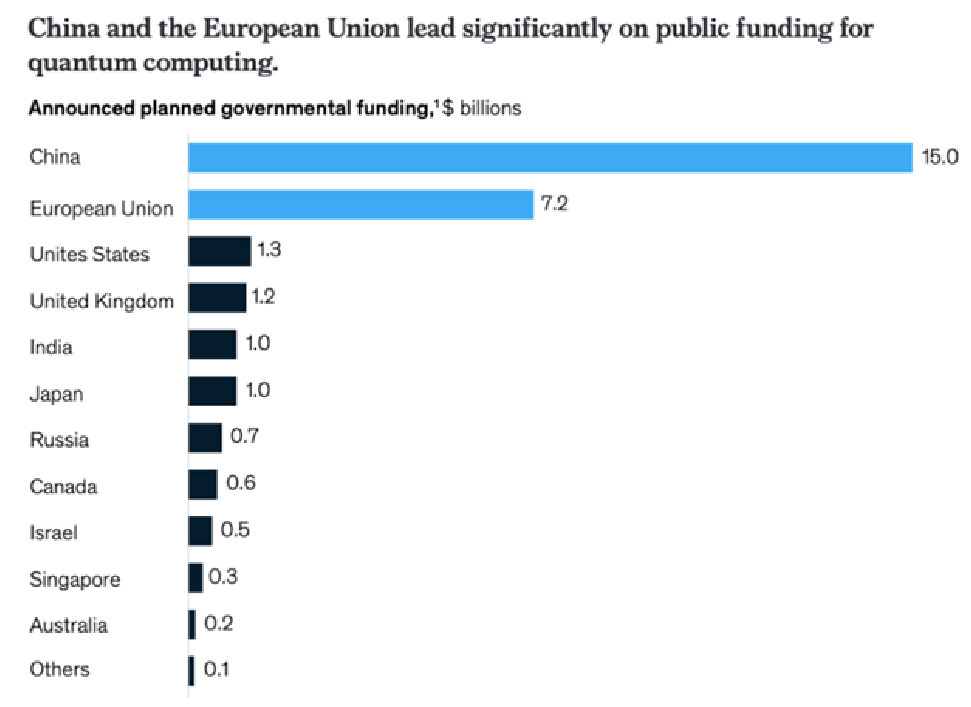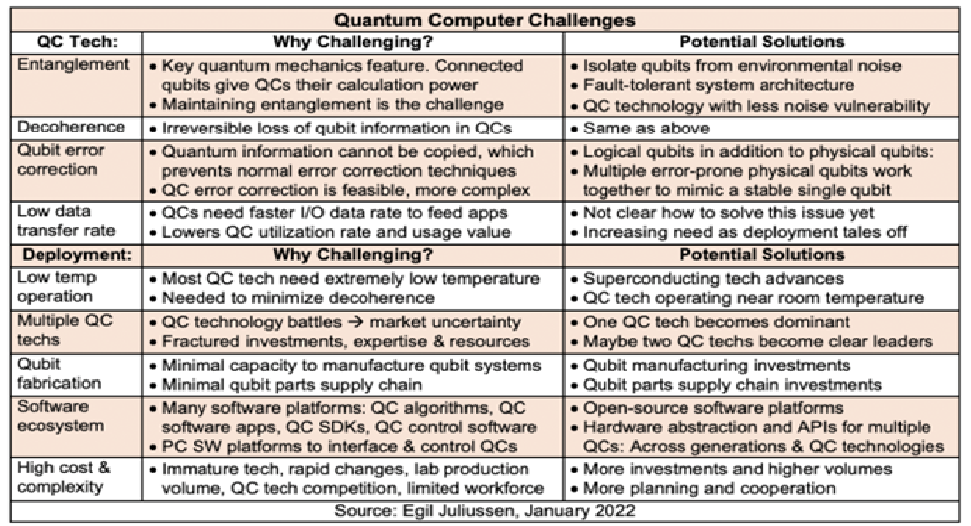The challenges of Quantum Computing
What is Quantum Computing?
It is a type of computation that harnesses the collective properties of quantum states, such as superposition, interference, and entanglement, to perform calculations. It harnesses the phenomena of quantum mechanics to deliver a huge leap forward in computation to solve complex problems.
Quantum mechanics is a science that describes the unique behavior of matter and energy at the atomic and subatomic level.
Quantum Computing works on:
‘Superposition‘ meaning they can exist in multiple states (both 0,1 at the same time) at the same time. It is unlike classical computers where information is processed in ‘bits’ or 1s and 0s, following classical physics.
‘Entanglement‘ where two or more particles are inextricably linked and mirror each other exactly, even when separated by great physical distance.
How are Quantum Computers better than Conventional Supercomputers?
- Conventional computers (in common use like homes/offices) and Supercomputers process information with bits (ones and zeroes). Quantum computers, on the other hand, use quantum bits or qubits that can process the ones and zeroes simultaneously due to a property known as superposition. This allows them to process a lot more information than conventional computers
- Conventional Supercomputers combine processing power of thousands of computers. However, supercomputers aren’t very good at solving certain types of problems e.g., Supercomputers don’t have the working memory to hold the myriad combinations of real world problems. Supercomputers have to analyze each combination one after another, which can take a long time.
- On the other hand, the computing power of quantum computers increases exponentially (by a factor of 2) with increase in qubits e.g., In October 2019, Google said it had performed a calculation on a quantum processor in 300 seconds that would have been practically impossible to achieve with the algorithms available at the time.
What are the various applications of Quantum Computing?
- Artificial Intelligence (AI) and Machine Learning (ML): Quantum computers’ abilities to parse through massive data sets, simulate complex models, and quickly solve optimization problems have drawn attention for applications within artificial intelligence. Quantum computing has the potential to enhance the pace of AI/ML.
- Computational Chemistry: There are many problems in finding the right catalyst or process to develop a new material, or an existing material more efficiently. A quantum computer can be used to simulate the quantum mechanical processes that occur. Potential applications include: (a) Finding new materials that can achieve a room temperature superconductor; (b) Finding a catalyst that can improve the efficiency of carbon sequestration; (c) Developing a new battery chemistry that can significantly improve the performance over today’s lithium-ion batteries.
- These applications can have uses in agriculture, manufacturing and industrial design sectors.
- Financial Portfolio Optimisation: Finding the optimum mix for a basketful of investments based upon projected returns, risk assessments, and other factors is a daily task within the finance industry. By utilizing quantum technology to perform these calculations, improvements can be achieved in both the quality of the solutions as well as the time to develop them.
- Logistics and Scheduling: Many common optimisations used in industry can be classified under logistics and scheduling. Quantum computing can make logistics more efficient. For example: (a) Airlines can figure out how to stage their airplanes for the best service at the lowest cost; (b) Factory managers can minimize cost, time and maximize output.
- Cyber Security: Cyber security is becoming a larger issue every day as threats around the world are increasing their capabilities and we become more vulnerable as we increase our dependence upon the digital system. Various techniques to combat cyber security threats can be developed using some of the quantum machine learning approaches to recognize the threats earlier and mitigate the damage that they may do.
Why should India focus on Quantum Computing?
- Industrial revolution 4.0: Quantum computing is an integral part of Industrial revolution 4.0. Success in it will help in Strategic initiatives aimed at leveraging other Industrial revolution 4.0 technologies like the Internet-of-Things, Machine Learning, robotics, and artificial intelligence across sectors and lay the foundation of the Knowledge economy.
- Growing Demand: According to The Quantum Revolution in India, The quantum ecosystem in India is growing at an accelerated pace with support from government agencies and participation from the academia, service providers, and the start-up community.
- Economic Benefits: The adoption of quantum technologies across industries could potentially add US$ 280–310 billion value to the Indian economy by 2030. Manufacturing, high-tech, banking, and defence sectors will remain at the forefront of quantum-led innovation, according to the Nasscom-Avasant report.
What steps have been taken to promote Quantum Computing in India?
- The National Mission on Quantum Technologies and Applications (NM-QTA): It is a government of India programme that aims to create a workforce of over 25,000 in India over the next 5-7 years. It has a total budget outlay of ₹8,000 crore for a period of five years.
- The next generation transformative technologies that will receive a push under this mission include quantum computers and computing, quantum communication, quantum key distribution, encryption, quantum devices, quantum sensing and so on.
- The areas of focus for the Mission will be in fundamental science, translation, technology development, human and infrastructural resource generation, innovation and start-ups to address issues concerning national priorities.
- QuEST: The Department of Science and Technology launched the Quantum-Enabled Science and Technology (QuEST) initiative to invest INR 80 crores to lay out infrastructure and to facilitate research in the field.
- ‘Quantum Computer Simulator (QSim) Toolkit’: It provides the first quantum development environment to academicians, industry professionals, students, and the scientific community in India.
- Other Efforts: Scientists from two Ahmedabad-based laboratories of the Department of Space jointly demonstrated quantum entanglement with real-time Quantum Key Distribution (QKD) between two buildings separated by a distance of 300 metres.
What are the associated challenges?
- First, quantum computers are highly prone to interference that leads to errors in quantum algorithms running on it. Thus it can give erroneous results. Scientists are working to improve accuracy e.g., Google has announced plans to have fault-tolerant quantum-computing hardware by 2030
- Second, most quantum computers cannot function without being super-cooled to a little above absolute zero since heat generates error or noise in qubits. Expanding quantum computing will increase ecological footprint.
- Third, finding the right talent is another big hurdle as there is an acute shortage of candidates with doctorates in quantum physics, engineering, and statistics.
- Fourth, a comprehensive multi-stakeholder network is amiss. It is not clear whether India will focus on near-term quantum applications or long-term applications or both. Translating research into real-world applications should be at the core of India’s quantum efforts.
- Fifth, metrics to assess the outcomes of India’s quantum efforts are not clearly defined. Merely achieving quantum supremacy will not necessarily safeguard India’s national interests.
- Sixth, India lacks the capability to domestically manufacture most of the components/hardware used in quantum computing. It is another strategic sector where India is import-dependent.
- What should be the approach going ahead?
- First, India should cooperate with the private sector and friendly nations who are working to address the critical bottlenecks of quantum computing e.g., Tech Mahindra’s research and development arm, Makers Lab, announced it has set up a quantum centre of excellence called QNxT in Finland to leverage the country’s expertise in quantum computing.
- Second, the Indian government had announced NM-QTA in 2020 but it is yet to get Cabinet clearance. This should be quickly approved and implemented.
- Third, the Government should also make sure that educational programs surrounding quantum computing and technology are provided with adequate support and completed on time e.g., the Defence Institute of Advanced Technology (DIAT) in Pune, launched an MTech in quantum computing in 2020. IBM has partnered with top-tier academic institutions in India to provide access to IBM quantum systems, while Microsoft Garage India has joined hands with IIT Roorkee to conduct lectures on quantum computing for an entire semester.
- Fourth, the funding support towards the technology also needs to be augmented. According to McKinsey, China and the European Union have taken a lead in public funding for quantum computing with investments worth US$ 15 billion and US$ 7.2 billion, respectively. The US, the UK and India follow but with much lesser spending.
Conclusion
Despite these hurdles, quantum computing is set to grow. It is likely to see a hybrid computing-operating model that combines conventional computing with emerging quantum computing before the latter comes of age. Change may come as early as 2030, as several companies predict they will launch usable quantum systems by that time. India must step-up the efforts to develop capabilities in quantum computing and technologies. China has already gained a significant lead in this strategic field, India must catch-up before the gap with China’s capabilities becomes too wide to plug.







